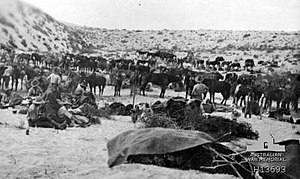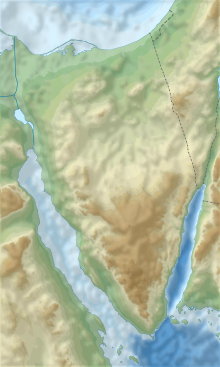| Battle of Romani | |||||||
|---|---|---|---|---|---|---|---|
| Part of the Middle Eastern theatre of World War I | |||||||
 8th Light Horse Regiment at Romani | |||||||
| |||||||
| Belligerents | |||||||
|
| |||||||
| Commanders and leaders | |||||||
|
Archibald Murray Herbert Lawrence Harry Chauvel | Friedrich Freiherr Kress von Kressenstein | ||||||
| Units involved | |||||||
|
Anzac Mounted Division's 1st Light Horse Brigade 2nd Light Horse Brigade 52nd (Lowland) Division |
3rd Division Pasha I Ottoman camel Machine gun battalion | ||||||
| Strength | |||||||
| 14,000 | 16,000 | ||||||
| Casualties and losses | |||||||
| 1,130 | 9,200 including 4,000 prisoners | ||||||
Location within Sinai | |||||||
The Battle of Romani was the last ground attack of the Central Powers on the Suez Canal at the beginning of the Sinai and Palestine campaign during the First World War. The battle was fought between 3 and 5 August 1916 near the Egyptian town of Romani and the site of ancient Pelusium on the Sinai Peninsula, 23 mi (37 km) east of the Suez Canal. This victory by the 52nd (Lowland) Division and the Anzac Mounted Division of the Egyptian Expeditionary Force (EEF) over a joint Ottoman and German force, which had marched across the Sinai, marked the end of the Defence of the Suez Canal campaign, also known as the Offensive zur Eroberung des Suezkanals and the İkinci Kanal Harekâtı, which had begun on 26 January 1915.
This British Empire victory ensured the safety of the Suez Canal from ground attacks and ended the Central Powers' plans to disrupt traffic through the canal by gaining control of the strategically important northern approaches to it. The pursuit by the Anzac Mounted Division, which ended at Bir el Abd on 12 August, began the Sinai and Palestine Campaign. Thereafter the Anzac Mounted Division supported by the Imperial Camel Brigade were on the offensive, pursuing the German and Ottoman army many miles across the Sinai Peninsula, reversing in a most emphatic manner the defeat suffered at Katia three months earlier.[1]
From late April 1916, after a German-led Ottoman force attacked British yeomanry at the Battle of Katia, British Empire forces in the region at first doubled from one brigade to two and then grew as rapidly as the developing infrastructure could support them. The construction of the railway and a water pipeline soon enabled an infantry division to join the Australian Light Horse and mounted rifle brigades at Romani. During the heat of summer, regular mounted patrols and reconnaissance were carried out from their base at Romani, while the infantry constructed an extensive series of defensive redoubts. On 19 July the advance of a large German, Austrian and Ottoman force across the northern Sinai was reported. From 20 July until the battle began, the Australian 1st Light Horse Brigade and 2nd Light Horse Brigade took turns pushing out to battle the advancing hostile column.
During the night of 3/4 August the advancing force, including the German Asia Corps (Pasha I) formation and the Ottoman 3rd Infantry Division, launched an attack from Katia on Romani. Forward troops quickly became engaged with the screen established by the 1st Light Horse Brigade. During fierce fighting before dawn on 4 August, the Australian light horse was forced to slowly retire. At daylight their line was reinforced by the 2nd Light Horse Brigade and about mid morning the 5th Mounted Brigade and the New Zealand Mounted Rifles Brigade joined the battle. Together these four brigades of the Anzac Mounted Division managed to contain and direct the determined German and Ottoman forces into deep sand. Here they came within range of the strongly entrenched 52nd (Lowland) Division defending Romani and the railway.
Coordinated resistance by the EEF formations, the deep sand, the heat and thirst prevailed, and the German, Austrian and Ottoman advance was checked. Although the attacking force fought strongly to maintain its positions the next morning, by nightfall they had been pushed back to their starting point at Katia. The retiring force was pursued by the Anzac Mounted Division between 6 and 9 August, during which the Ottomans and Germans forces fought several determined rearguard actions against the advancing Australian light horse, British yeomanry and New Zealand mounted rifle brigades. The pursuit ended on 12 August, when the German and Ottoman force abandoned their base at Bir el Abd and retreated to El Arish.
- ^ Battles Nomenclature Committee 1922, p. 31.
